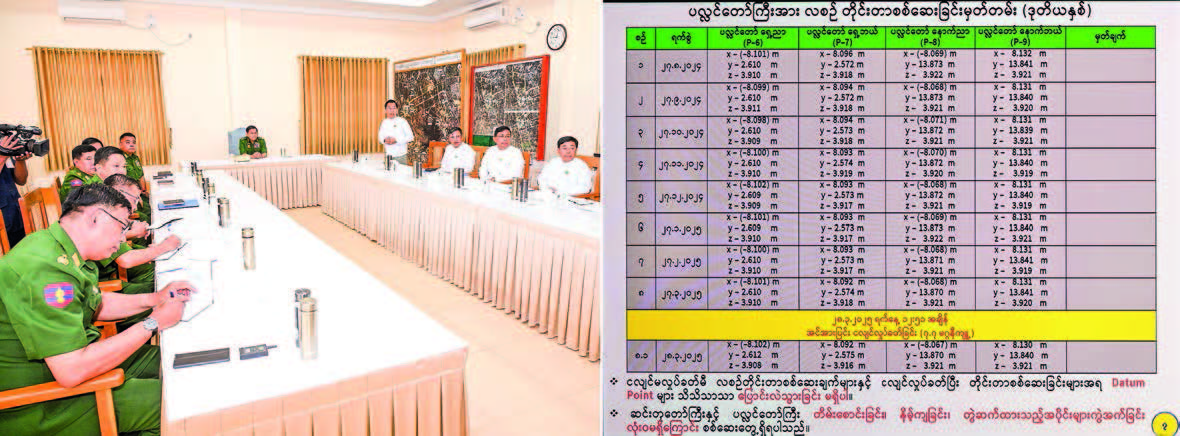No damage or unusual state was found at Maravijaya Buddha Image but other religious edifices have seen some extent of damage.
CHAIRMAN of the State Administration Council Commander-in-Chief of Defence Services Senior General Min Aung Hlaing yesterday morning inspected the damage to the Maravijaya Buddha Image which is the tallest sitting marble Buddha image worldwide and other religious buildings in the precinct of the Buddha Park in Dekkhinathiri Township of Nay Pyi Taw.
At the office of the Image Board of Trustees, Chairman of the Board U Thant Swe, Union Minister for Energy U Ko Ko Lwin and Director of Military Engineers Maj-Gen Zaw Naing Oo, Union Minister for Construction U Myo Thant and officials reported to the Senior General on daily and monthly checking the datum points and measurements of the Image and the throne, no change in datum points of these structures after the earthquake struck on 28 March, no unusual state of the image and the throne, some damaged parts at the terrace, Gandakuti chamber and slabs as well as some religious buildings, and repair process, systematic checking the structures of the Image in the shocks of earthquake with the use of modern technology to set records, systematic repair of some damaged parts and preventive measures for future earthquakes.
In his response to the reports, the Senior General said that from the very beginning of the construction of the Maravijaya Buddha Image, careful planning and modern engineering techniques were employed to ensure its long-term durability, resilience against strong winds, earthquake resistance, and protection from natural disasters. Hence, despite the occurrence of a severe earthquake, he continued that the image and its terrace did not experience any tilting, subsidence, or structural fractures. So, he added that officials have to oversee the repairing of only minor damages and systematically repair and maintain the structures as necessary.
The Senior General cordially greeted the pilgrims at the Buddha image. He inspected the precinct of the image and the passage of the Gandakuti chamber and maintenance of some damaged parts. He then beat the bell of the image.
The Senior General also looked into damaged parts of Aggadhipati Sasana Beikman and gave necessary guidance to officials.
In a meeting with the chair and members of the Image Board of Trustees, the Senior General said that the severe earthquake posed a significant challenge for engineers and engineering technologies. During such an extremely intense and rare earthquake, it is a great source of pride that the Maravijaya Buddha Image and its grand platform did not experience any tilting, subsidence, or cracks in their attached parts, and that damage to other religious structures was minimal. Hence, it is necessary to systematically maintain the Image and religious buildings for their long-term existence.
The Maravijaya Buddha Image was sculpted in separate sections using CNC machines in a step-by-step carving process. Modern engineering techniques were applied to ensure the structural integrity of the image during the assembly of its parts. To ensure the long-term durability of the sacred Buddha image, the foundation was designed to withstand up to 20,000 tonnes. It was also engineered to endure wind speeds of up to 120 miles per hour from severe storms, withstand earthquakes of up to 8.8 magnitude—the highest recorded seismic activity in Myanmar – and remain unaffected by lightning strikes. The entire construction was meticulously calculated and executed from an engineering perspective to ensure its resilience and longevity. The connection of the large rocks of the Buddha Image was carried out using a combination of traditional methods and modern engineering techniques. The Maravijaya Buddha Image, standing 63 feet tall with an 18 feet high throne, reaching a total height of 81 feet, was successfully built and enshrined as the world’s largest Buddha image in conformity with the architectural style of the Yadanabon era, blended with modern construction techniques to create a magnificent and awe-inspiring structure. Remarkably, despite experiencing a powerful earthquake, the statue sustained no damage, demonstrating an impressive feat of engineering excellence. — MNA/TTA


